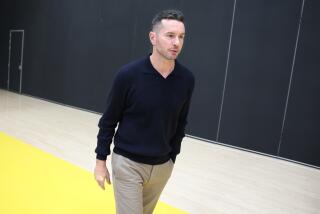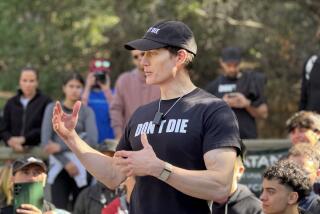Hey, howâs your M-health?
People use wireless technology to communicate, game and entertain. USCâs Center for Body Computing asks why not use that same tech to get fit or manage a health condition? At the centerâs annual conference, innovators presented ways in which health technology merges with social media, entertainment, sports and fitness.
The Center for Body Computing works with startups and other partners to develop wireless health products. Body computing could mean using your computer to track calories burned, posting your heart rate on Instagram or browsing YouTube for diabetic-friendly recipes. In sports, it could mean monitoring for head injuries. Whatever the project, body computing makes health-tech digital and accessible; hence the nickname âM-health,â or mobile health. âWe can even make it fun,â said Leslie Saxon, a cardiologist and the centerâs executive director.
Itâs all part of a âveritable shakeupâ bringing health technology out of the clinic and into the home, Eric Topol, a cardiologist at Scripps Clinic in La Jolla and author of âThe Creative Destruction of Medicine: How the Digital Revolution Will Create Better Healthcare,â said in an interview.
Here are five innovations discussed at the conference, held Oct. 4 on the campus.
Armed with facts
How many calories did you burn in the last week? How much did you move around? How well did you sleep?
Wearable fitness monitors are a popular fashion accessory for the fit crowd -- among them the armband from BodyMedia ($99-$119, www.bodymedia.com/Shop/Armband-Packages). The armband sensor collects more than 5,000 bits of data every minute, calculating activity from temperature, movement, sweating and heat loss.
But not everyone needs all that data all the time. Within the next six months, BodyMedia plans a disposable patch called the Media BodyMedia Vue -- like an oversized Band-Aid -- that will allow users to collect data for a week, and then upload via the built-in USB port.
You might show the info to your weight-loss coach or trainer, or doctor or sleep therapist, so they can figure out just what you need to change to meet your health and fitness goals, suggested Ivo Stivoric, vice president for research and development at Jawbone, BodyMediaâs parent company.
The new patch will cost less than $50, said Deepak Prakash, director of digital health marketing at Vancive Medical Technologies, an Avery Dennison business, which co-developed the patch and plans to market its version as the Medtria IH1.
--
BioGram improves your image
You can share pictures of whatever makes your heart flutter on Instagram. With the new BioGram app, developed by the Center for Body Computing, you can show the world what those images did to your pulse. The app adds a little heart icon with your heart rate to the photos, so your friends can see just how excited you are about that recent touchdown, latest date, whatever.
âItâs fun, itâs about sharing yourself,â Saxon said.
To use BioGram, youâll need the AliveCor Heart Monitor, a phone attachment that picks up heart rate from your fingertips in a few seconds ($199, prescription required, www.alivecor.com/). AliveCor provides a portable electrocardiogram that people with heart concerns can use to monitor their health, and others could use to build up a record of their normal rhythms.
Saxon hopes the app will be available by the end of 2013. The basic version will be free, with more advanced features for a price.
--
Big impact on contact sports
In sports from Pee Wees to pros, a blow to the head can cause a serious injury. But the athlete might not always know when theyâve sustained a head injury like a concussion, and coaches may not witness every impact.
The Reebok Checklight, launched in July, is a sensor fitted in a soft, wear-alone or under-helmet skullcap (ages 6 and up, $149.98, https://bit.ly/19Uvwoc). It uses an accelerometer and gyroscope to identify head blows. The light on the back of the cap flashes yellow for moderate impact, red for severe. Reebok recommends athletes who get a warning light step off the field until checked by a doctor or trainer.
The goal: âPlay a safer game,â said former NFLer Isaiah Kacyvenski, now director of sports at MC10, which developed the sensor in the Checklight. Players who get the warning lights can learn to modify their technique.
--
A lot of data without hoopla
The SportVu program from STATS, a sports tech and data company, aims to track the prowess of pro basketball players without even touching them. The program uses six cameras in arena rafters to record every dribble, pass and shot. STATS worked with 15 teams last year, and this season the NBA has made SportVu leaguewide.
Some of the data will be available to fans. Coaches will get a more detailed analysis, telling them how fast each player is moving and how often he speeds up or slows down. That indicates the intensity of exertion and load on the athleteâs legs.
This kind of data can flag early warning signs of players who might be in trouble, said Paul Robbins, director of elite performance at STATS. For example, the statistics might show that a playerâs intensity drops. Sometimes, that fatigue might predict an injury in the next game. Coaches will know when to push players and when to let them recover.
âI think every coach wants to know how hard their players are working and how to recover them effectively and not put them at risk for injury,â said USC womenâs basketball coach Cynthia Cooper-Dyke, who attended the presentation.
--
YouTube video for diabetics
Watching YouTube could benefit your health. The Center for Body Computing partnered with Tastemade, online videoâs answer to TVâs Food Network, to create a cooking video for people with diabetes.
One of the biggest challenges for people with diabetes, Saxon noted, is to maintain a steady carb intake. In the video, sponsored by the center and premiered at the conference, Tastemade personality Dani Spies shows viewers of her âClean & Deliciousâ program how to make three carb-based meals in just five minutes each ( https://bit.ly/1euqDU9). The secret, Spies explains, is a big pot of brown rice made over the weekend and kept on hand.
For breakfast, Spies offers an apple pie-inspired rice bowl with milk, maple syrup and fruit. For lunch, itâs a rice and bean bowl with avocado and tomatoes. For dinner, she whips up a brown rice quesadilla with cheddar and broccoli. As she says in the video, âNobodyâs ever going to believe you made this in five minutes ... delicious, constant carb intake all day long.â
--


